The coronavirus pandemic has seen a rise in harmful and misleading conspiracy theories, mostly spreading online. To address this trend, the European Commission and UNESCO are publicising a set of ten educational infographics helping citizens identify, debunk and counter conspiracy theories.
Be warned: the COVID-19 pandemic has seen a rise in harmful and misleading conspiracy theories. It may be difficult to recognise them or know how best to deal with them.
What are conspiracy theories? Why do they flourish?
- 1. What are they?
The belief that certain events or situations are secretly manipulated behind the scenes by powerful forces with negative intent.
- 2. Conspiracy theories have these 6 things in common
- An alleged, secret plot.
- A group of conspirators.
- ‘Evidence’ that seems to support the conspiracy theory.
- They falsely suggest that nothing happens by accident and that there are no coincidences; nothing is as it appears and everything is connected.
- They divide the world into good or bad.
- They scapegoat people and groups.
- 3. Why do they flourish?
They often appear as a logical explanation of events or situations which are difficult to understand and bring a false sense of control and agency. This need for clarity is heightened in times of uncertainty like the COVID-19 pandemic.
- 4. How do they take root?
Conspiracy theories often start as a suspicion. They ask who is benefiting from the event or situation and thus identify the conspirators. Any ‘evidence’ is then forced to fit the theory.
Once they have taken root, conspiracy theories can grow quickly. They are hard to refute because any person who tries is seen as being part of the conspiracy.
- 5. People spread conspiracy theories for different reasons:
Most believe they are true. Others deliberately want to provoke, manipulate or target people for political or financial reasons. Beware: They can come from many sources e.g. internet, friends, relatives.
The first step to prevent conspiracy theories is to know that they exist. Be aware. Stop the spread.
Is this a conspiracy theory? Check before sharing
1. Check the author – who is writing this and why?
- Unlikely to be a conspiracy theory
- The author has recognised qualifications and credentials in the topic
- The author uses verifiable facts and evidence from scientific or academic research
- Likely to be a conspiracy theory
- The author is a self-proclaimed expert and not attached to a reputable organisation or institution
- Author claims to have credentials but they don’t withstand scrutiny or are suspended
- Unlikely to be a conspiracy theory
- The source has been quoted by several reputable media outlets
- The information is backed by many scientists/academics
- Independent fact-checking websites support the source and related claims
- Likely to be a conspiracy theory
- The source of information is not clear
- The information is shared only by self-proclaimed experts
- Independent fact-checking websites do not support the source and have refuted related claims
- Unlikely to be a conspiracy theory
- The author does not shy away from exploring complexity, including different perspectives
- The author is prepared to acknowledge limits to their knowledge
- The tone is objective, factual
- Likely to be a conspiracy theory
- The author presents their information as the only valid truth
- The author raises questions instead of providing answers
- The author demonises whoever they assume is behind the alleged secret plot
- The tone is subjective, emotionally charged
- Emotional images or anecdotes are used to illustrate the message
What is a real conspiracy?
Real conspiracies large and small do exist. They are more often centred on single, self-contained events or an individual like an assassination or a coup d’etat. They are unearthed by whistle-blowers and the media, using verifiable facts and evidence.
Looking for a real conspiracy? In 2006, the U.S. District Court in Washington DC (USA) ruled that major cigarette companies were guilty of conspiracy. For decades, they had hidden evidence of health risks attached to smoking to promote higher sales. (LA Times, 2006)
Check your sources. When in doubt, don't share. Stop the spread.
Conspiracy theories: What about my own beliefs?
Nobody is free of biases or fears, which could open the door to believing in a conspiracy theory.
Where do my fears, beliefs and values come from?
Interview yourself: Why do I believe what I believe?
- What are my fears, beliefs and values? How do they affect my decisions and how I interact with people?
- Do I have prejudices and believe in stereotypes? Why?
- Do I feel disadvantaged? In what way?
- Do I feel the need to blame somebody else? Why?
- How do I choose my sources of information?
- Has this changed since the COVID-19 outbreak?
COVID-19 is frightening. It's normal to feel overwhelmed and search for answers.
Keep in mind: Nobody is responsible for creating the virus but we all can help curb the outbreak.
Be aware of information overload. Rely on verified information. Stop the spread.
Conspiracy theories can be dangerous
Conspiracy theories often target or discriminate against an entire group perceived as the enemy behind a real or imagined threat. They polarise society and fuel violent extremism. While most people who spread conspiracy theories genuinely believe in them, others deploy them cynically to achieve these effects.
How conspiracy theories damage
- They identify an enemy and a secret plot that threatens peoples' lives or beliefs and spark a defence mechanism, which can fuel discrimination, justify hate crimes and can be exploited by violent extremist groups.
- They spread mistrust in public institutions, which can lead to political apathy or radicalization.
- They spread mistrust in scientific and medical information, which can have serious consequences.
Watch out: Perceived "out groups" of society are especially prone to be targets of conspiracy theories, hate speech and disinformation campaigns. This includes people of different origin, religion or sexual orientation. In the context of COVID-19, specific groups were frequently falsely blamed for the spread of the virus in Europe, including people of assumed Asian origin, Jews, Muslims, Roma, and people who identify as LGBTI+ (FRA, 2020).Conspiracy theories can have serious consequences. Take them seriously. Check before sharing. Stop the spread.
Conspiracy theories: The link to antisemitism
Not all conspiracy theories target Jews, but Jews have been the target of conspiracy theories for centuries. Jews have been falsely blamed for moments of crisis, such as diseases, wars, and economic crises.
Some of the most common antisemitic narratives include claims that “Jews” control the government, the media, or banks for malicious purposes. Despite vast historical evidence, some antisemites falsely claim that the Holocaust was caused by Jews or never took place.
What to watch out for:
- Openly insulting and demeaning language
- Implicit and coded antisemitic language (e.g. “East Coast elites” in the United States)
- Linking an alleged conspiracy to Jewish individuals or groups (e.g. the Rothschild family or George Soros, a philanthropist) or the State of Israel
- References to The Protocols of the Elders of Zion, a forged pamphlet of a Jewish plan for world domination behind many antisemitic conspiracy narratives.
Antisemitism is a form of discrimination. Check before sharing. Stop the spread.
Prebunking and debunking conspiracy theories
Stopping the spread of conspiracy theories is challenging. There is no one-size-fits-all approach. It depends on the level of exposure. People who firmly believe in conspiracy theories are extremely difficult to reach.
Level 1: Low exposure to conspiracy theories
PREBUNKING – Empowered people are more resilient
- Warn people early on that conspiracy theories exist.
- Encourage rational thinking, questioning and fact-checking.
- Alert people about the arguments behind the most common COVID-19 conspiracy theories and the key traits of conspiratorial thinking – suspicion of official accounts, immunity to contrary evidence, reinterpreting random events as part of a broader pattern.
Level 2: High exposure to conspiracy theories
DEBUNKING – Facts and logic matter
DOs
- Focus on the facts you want to communicate, not the myth you want to debunk.
- Choose your target – the author, source or logic behind the conspiracy theory.
- Always state clearly that the information is wrong, before quoting a conspiracy theory.
- Provide a fact-based alternative explanation.
- If possible, use visual aids to back your argument.
DON'Ts
- Don't focus on the conspiracy theory first. Don't reinforce it.
- Don't overwhelm with information.
Know how to take action. Stop the spread.
How to talk to somebody who firmly believes in conspiracy theories
Many conspiracy theorists are deeply convinced of their beliefs. Their whole life and worldview are centred around them.
When talking to somebody who firmly believes in a conspiracy theory be aware that:
- Any argument challenging the conspiracy theory may be taken as proof that you are part of the conspiracy and reinforce the belief.
- They probably believe in more than one conspiracy theory.
- They will probably argue hard to defend their beliefs.
So, what can you do?
- Encourage open debate and questions.
- Ask detailed questions about their theory in order to trigger self-reflection.
- Enlist trusted former conspiracy theorists who once believed the same thing.
- Be cautious and use a variety of sources around the theme.
- Don't ridicule. Try to understand why they believe what they believe.
- Show empathy. Often the person may be truly fearful and distressed.
- Go step by step. Focus on simple facts and logic instead of covering every detail.
- Don't push. Too much pressure might backfire. Leave them time to process and try again.
Use empathy and questions. Stop the spread.
Conspiracy theories: The link to COVID-19
COVID-19 is a new disease caused by the most recently discovered coronavirus. Scientific evidence shows that coronaviruses generally originate from animals. The animal source for COVID-19 has not been confirmed yet (WHO, 2020).
Uncertainty, fear and the complexity of the COVID-19 pandemic have fuelled related conspiracy theories. They attempt to ‘explain’ why the pandemic happened and who is benefiting from it.
A global study of 28 counties revealed that more than 3 in 10 people surveyed believe that a foreign power or another force is deliberately causing the spread of the COVID-19 virus (Gallup International, March 2020).
Be careful, conspiracy theories are deceptive: they ignore scientific evidence and falsely blame individuals and groups that are not responsible for the pandemic. Do not share them.
What are the red flags?
- Claims that the virus was artificially created (e.g. in a laboratory) by people with a specific interest (e.g. reducing world population).
- Claims that the virus was spread intentionally, or its natural spread artificially augmented to harm as many people as possible (e.g. through 5G signals).
- Claims that vaccines and cures are intentionally withheld to not disrupt the spread and to harm as many people as possible.
- Claims that certain sanitary measures to counter the spread of the virus are used to intentionally harm or control society (e.g. vaccines, masks).
Keep in mind: Nobody is responsible for creating the virus, but we can all help to curb the outbreak.
Rely on verified information. When in doubt, don't share. Stop the spread.
Concrete counter actions against conspiracy theories
If you are certain you have identified a conspiracy theory, react rather than ignore. Here are some concrete ways:
On social media:
- Comment with verified information (e.g. from fact-checking websites)
- DO NOT share the post
On websites and blogs:
- Contact the author or the web manager with verified information and ask them to make corrections
- DO NOT share the website or blog post
On media outlets:
- Contact the editorial board
- Contact your local/national press council or press ombudsperson
- DO NOT share the material
Rely on verified information. Counter false information. Stop the spread.
How can journalists report on conspiracy theories?
Reliable sources of information are essential to counter the spread of conspiracy theories and disinformation. Journalists should report responsibly using verified sources, making sure not to reinforce conspiracy theories. This can be a challenge.
In reporting on conspiracy theories, journalists should:
- Emphasise core facts, not conspiracy theories in headlines
- Reinforce core facts in the main text, using verified information
- Warn about related conspiracy theories circulating, before referencing them
- Explain how they are misleading
Be a quality journalist. Rely on verified information. Stop the spread.
With thanks to Michael Butter, co-author of the COMPACT Guide to Conspiracy Theories, and John Cook and Stephan Lewandowsky, authors of The Debunking Handbook and The Conspiracy Theory Handbook.
Infographics
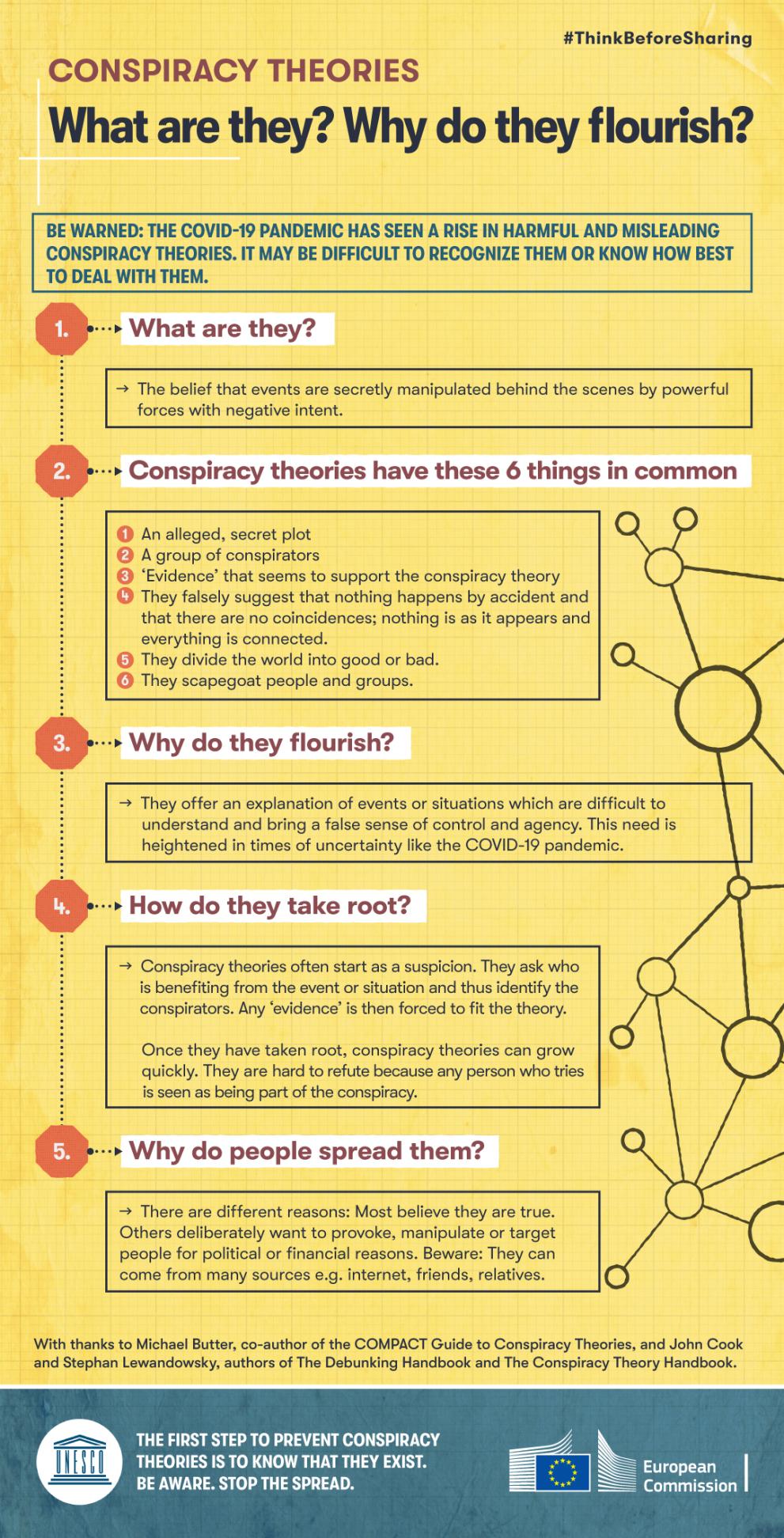
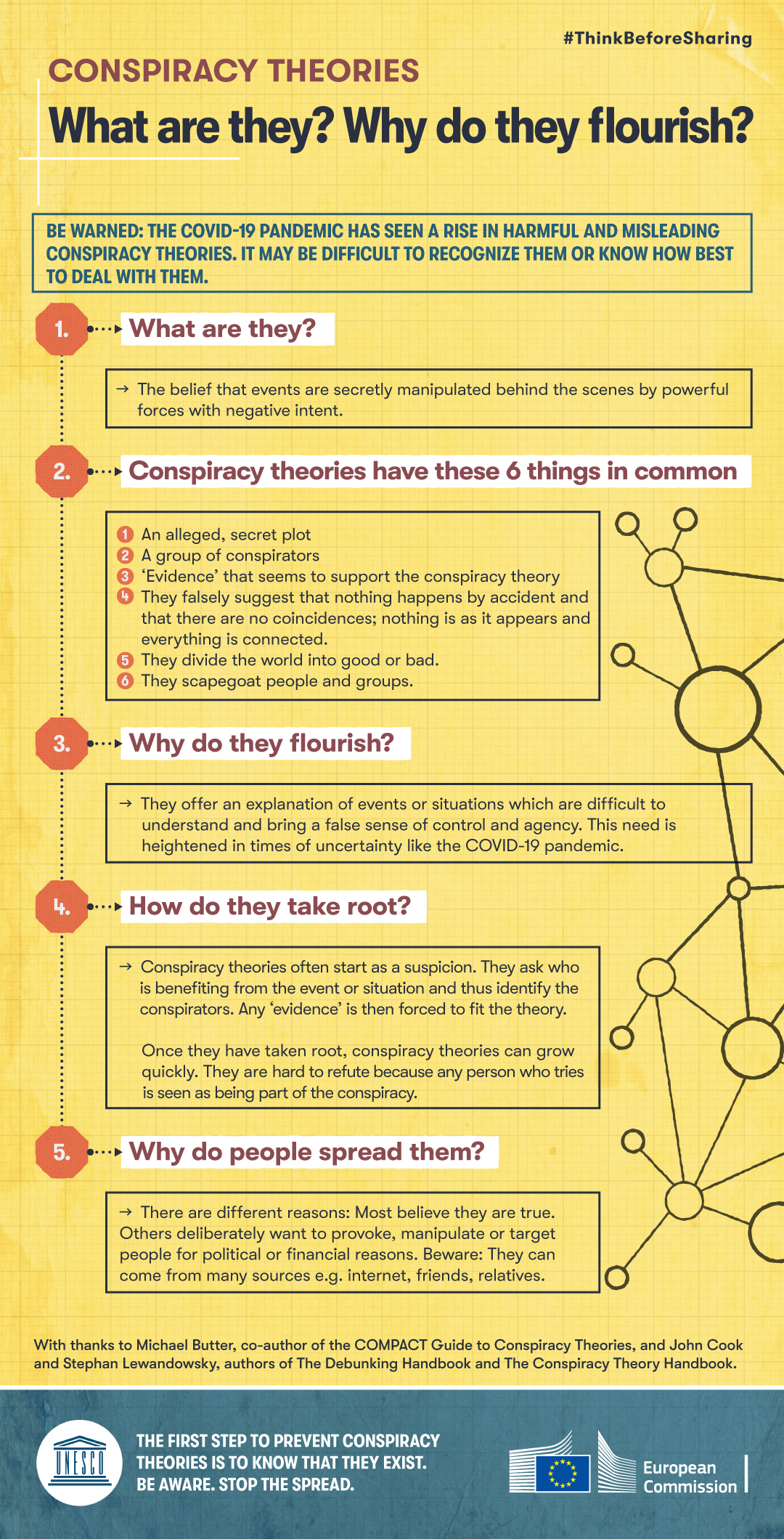
unesco-conspiracy-english-0.jpgunesco-conspiracy-english-0.jpg 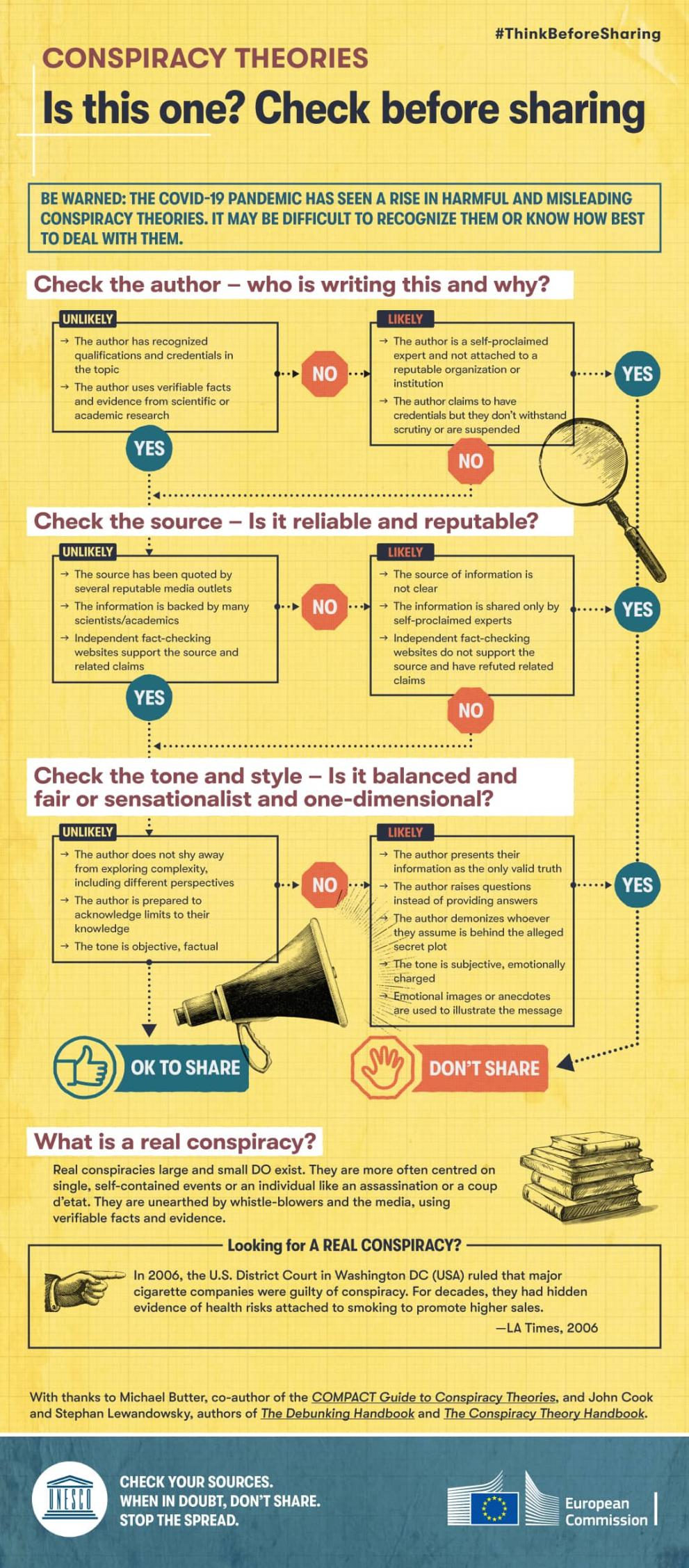
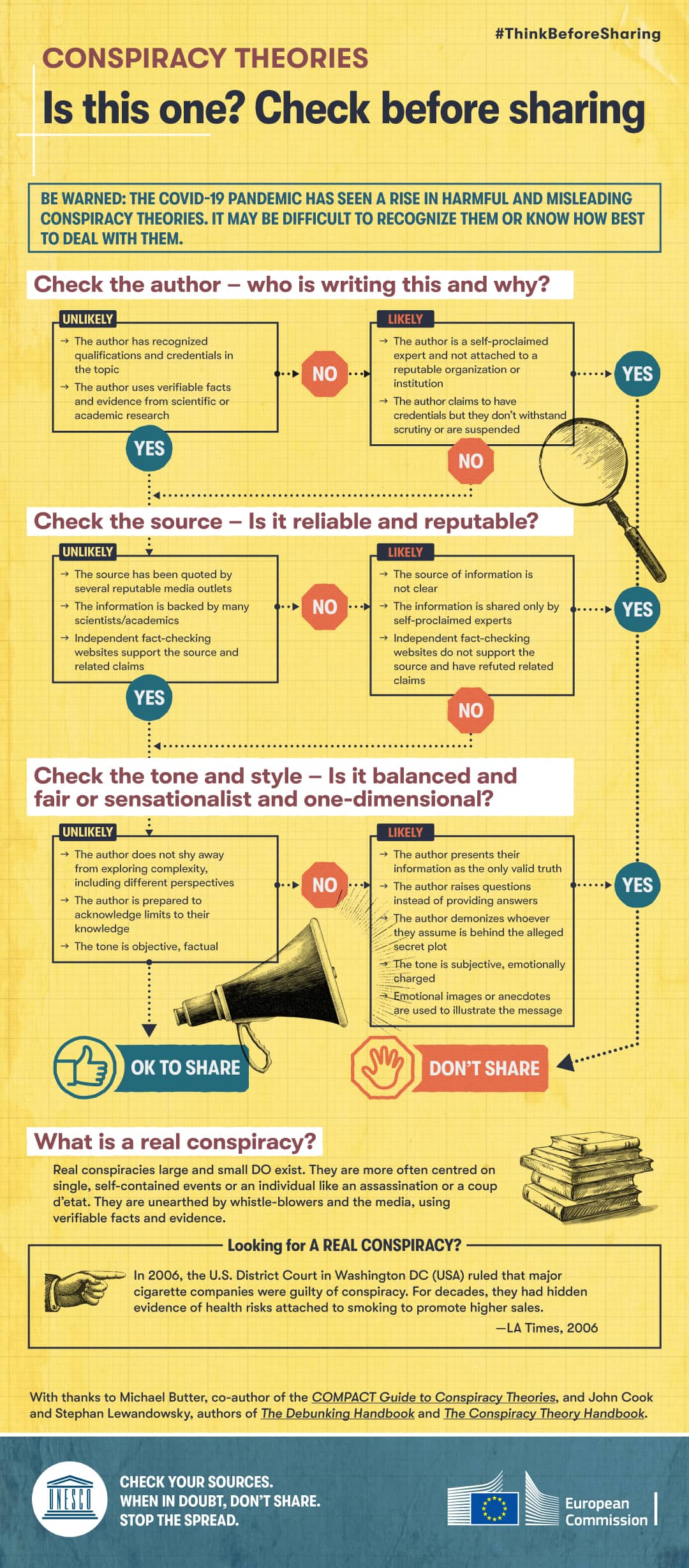
unesco-conspiracy-english-1.jpgunesco-conspiracy-english-1.jpg 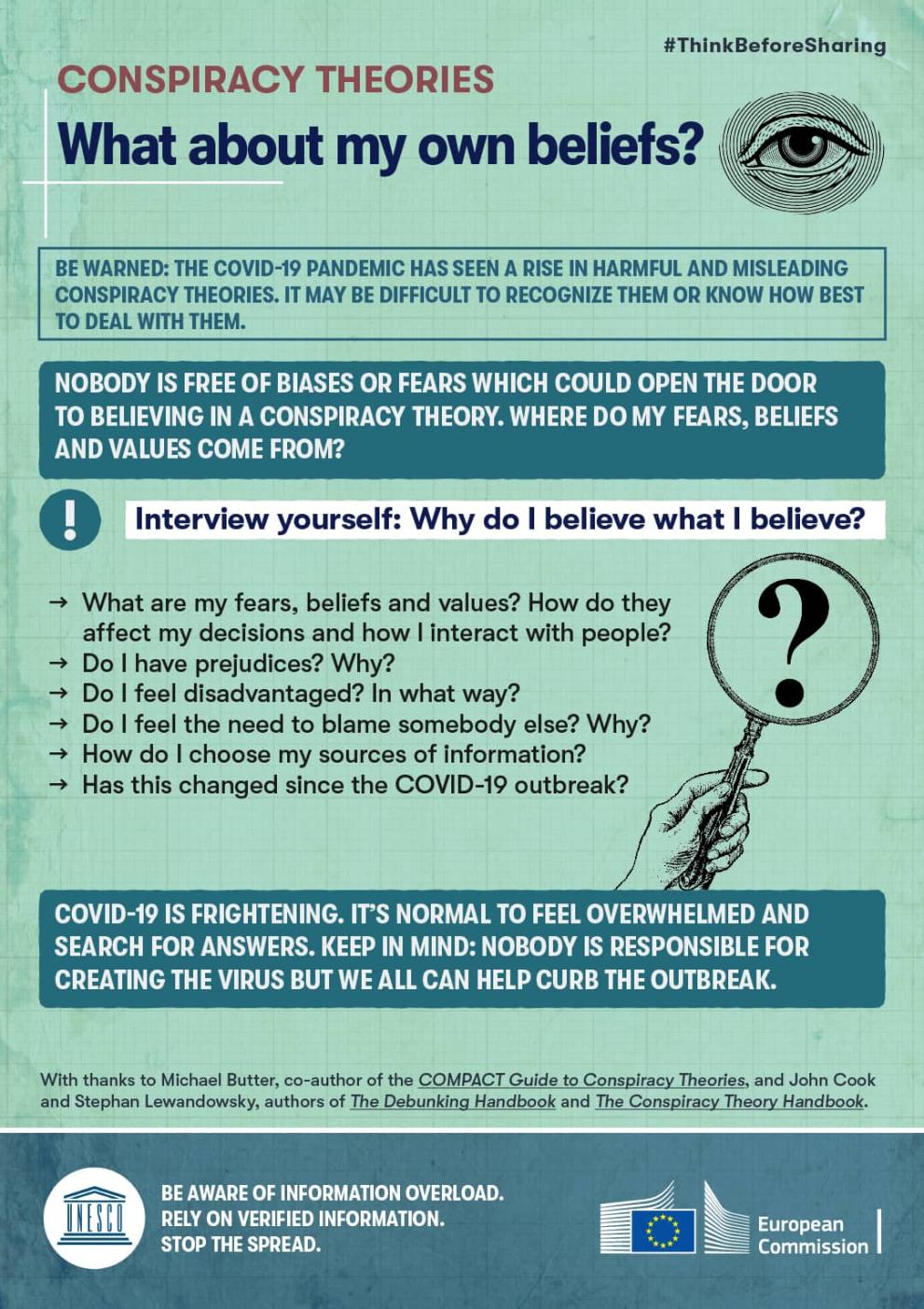

unesco-conspiracy-english-2.jpgunesco-conspiracy-english-2.jpg 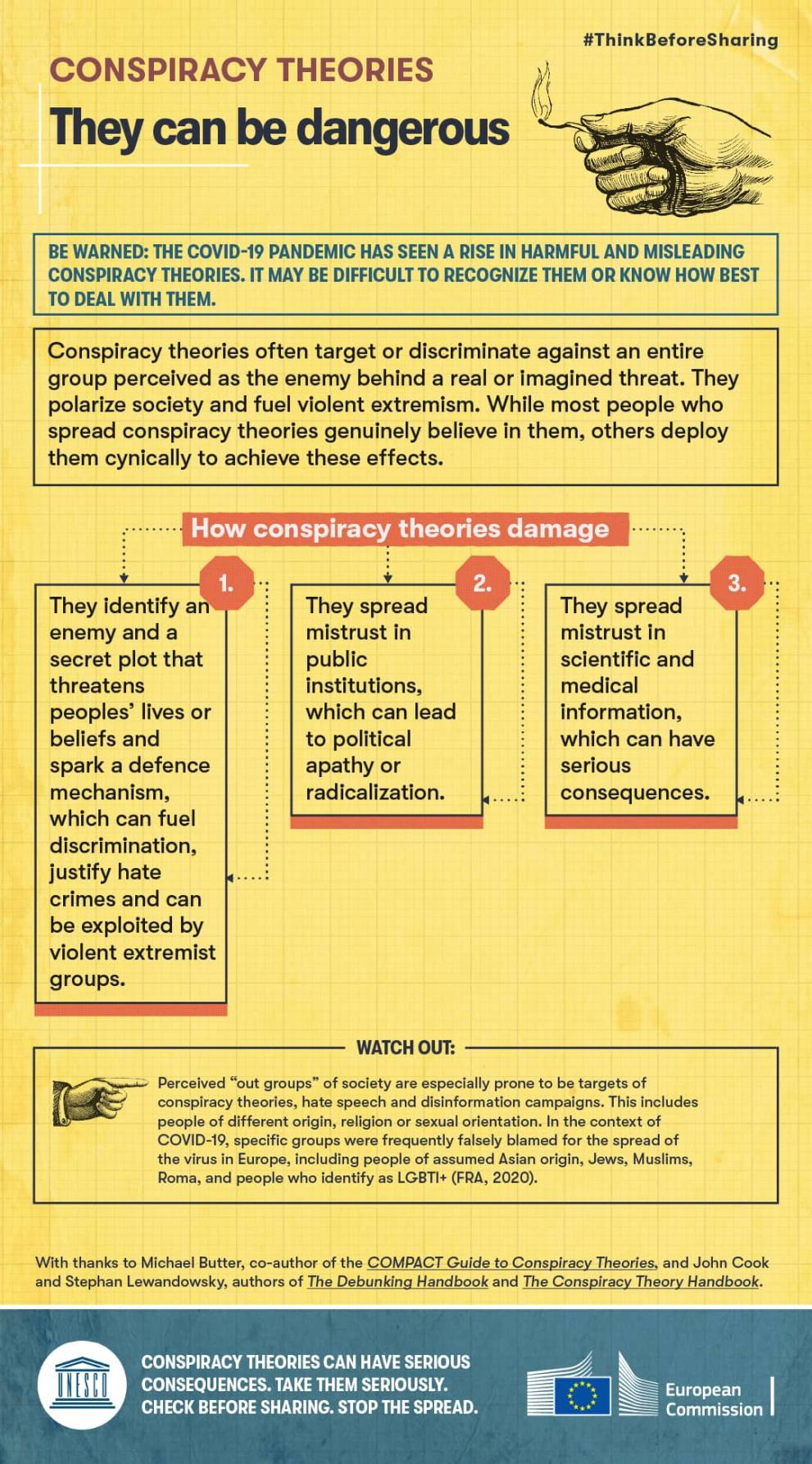

unesco-conspiracy-english-3.jpgunesco-conspiracy-english-3.jpg 
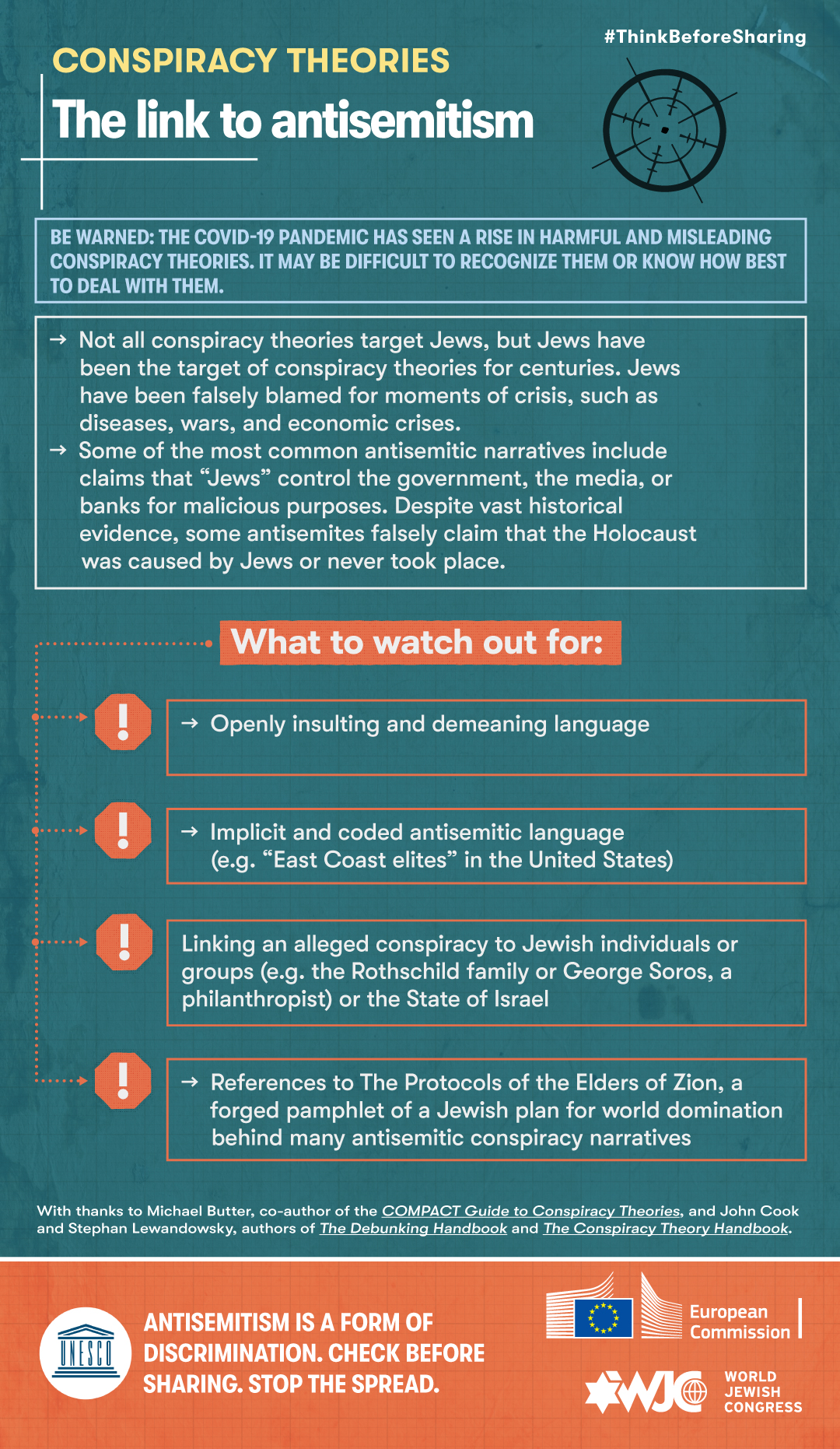
unesco-conspiracy-english-4.jpgunesco-conspiracy-english-4.jpg 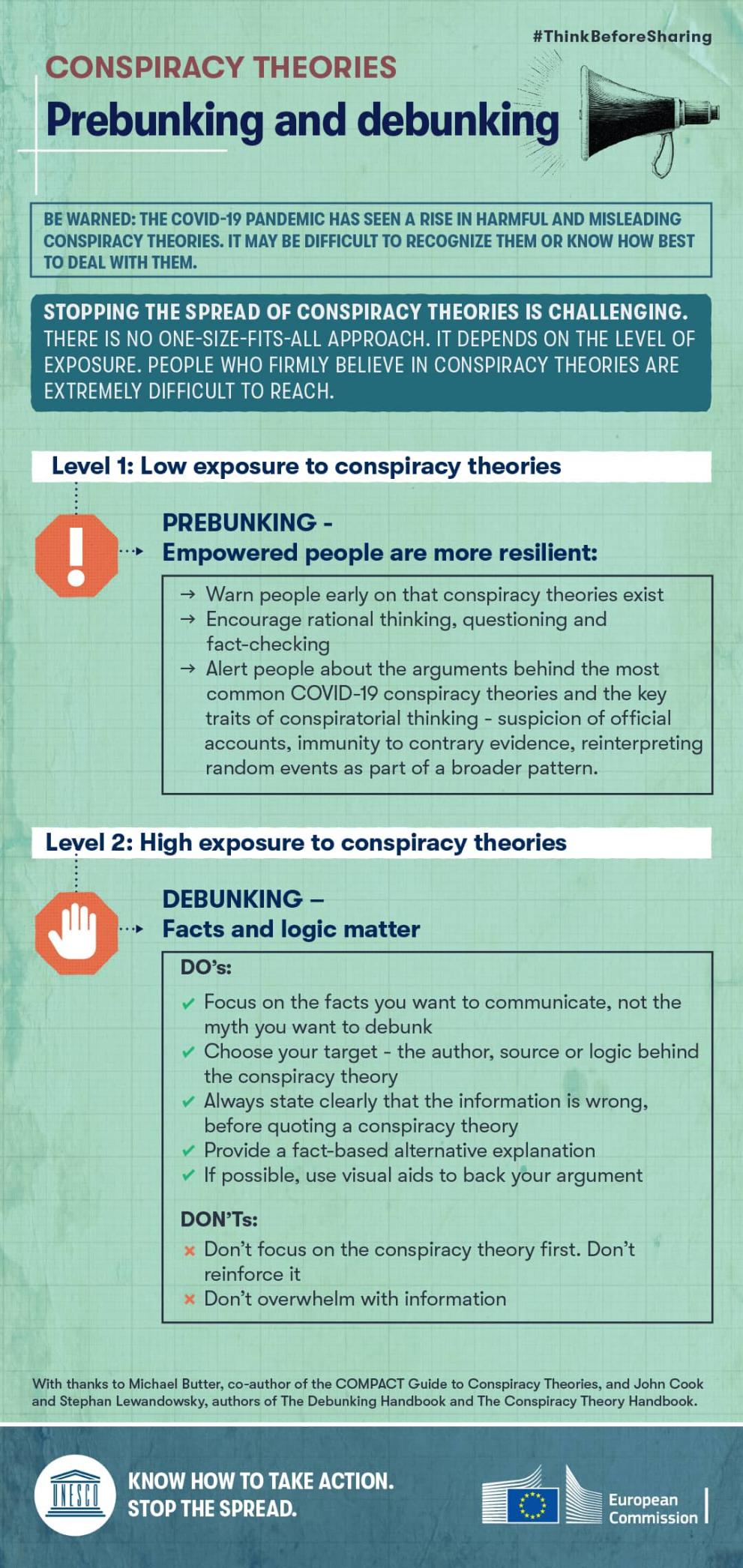
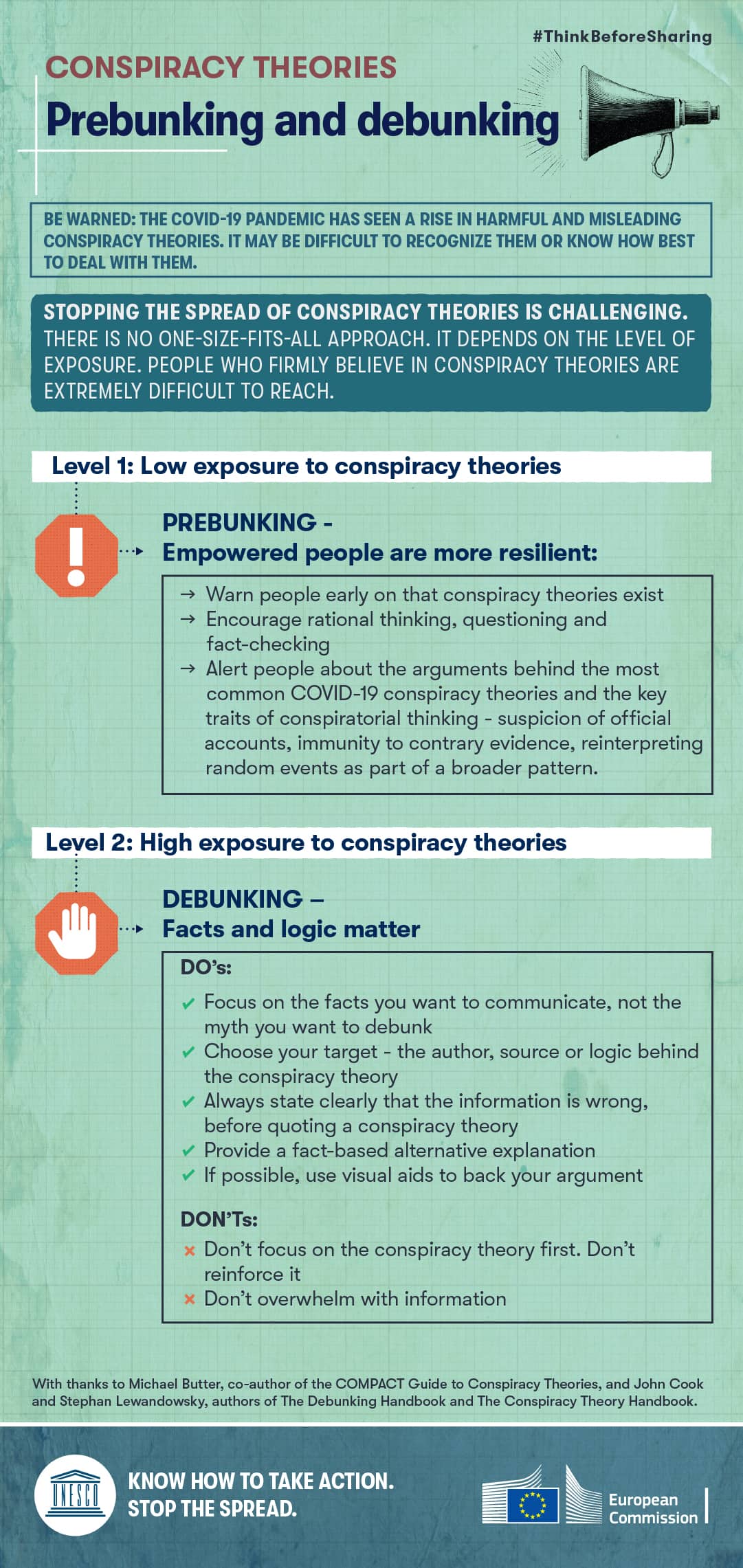
unesco-conspiracy-english-5.jpgunesco-conspiracy-english-5.jpg 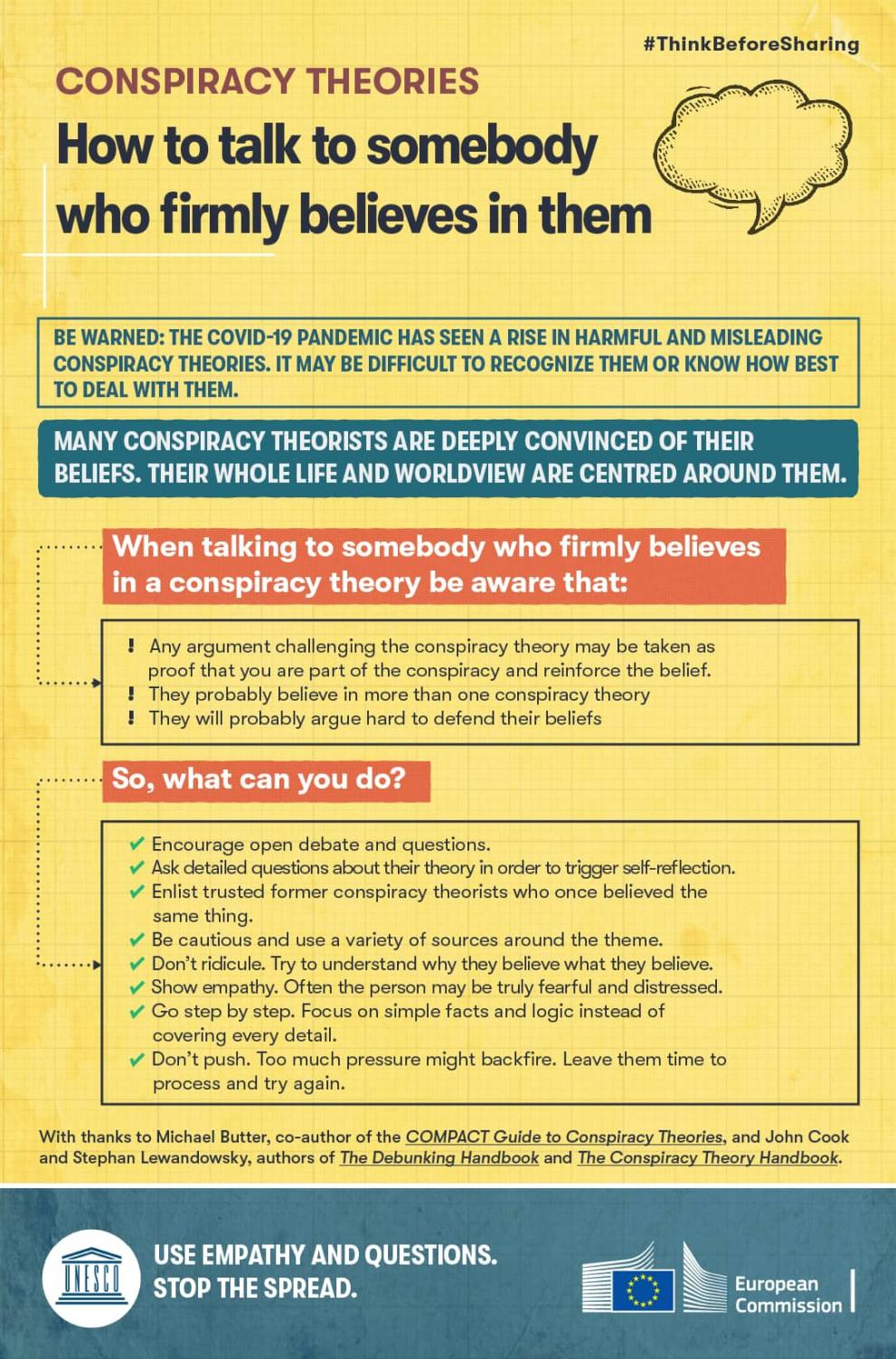

unesco-conspiracy-english-6.jpgunesco-conspiracy-english-6.jpg 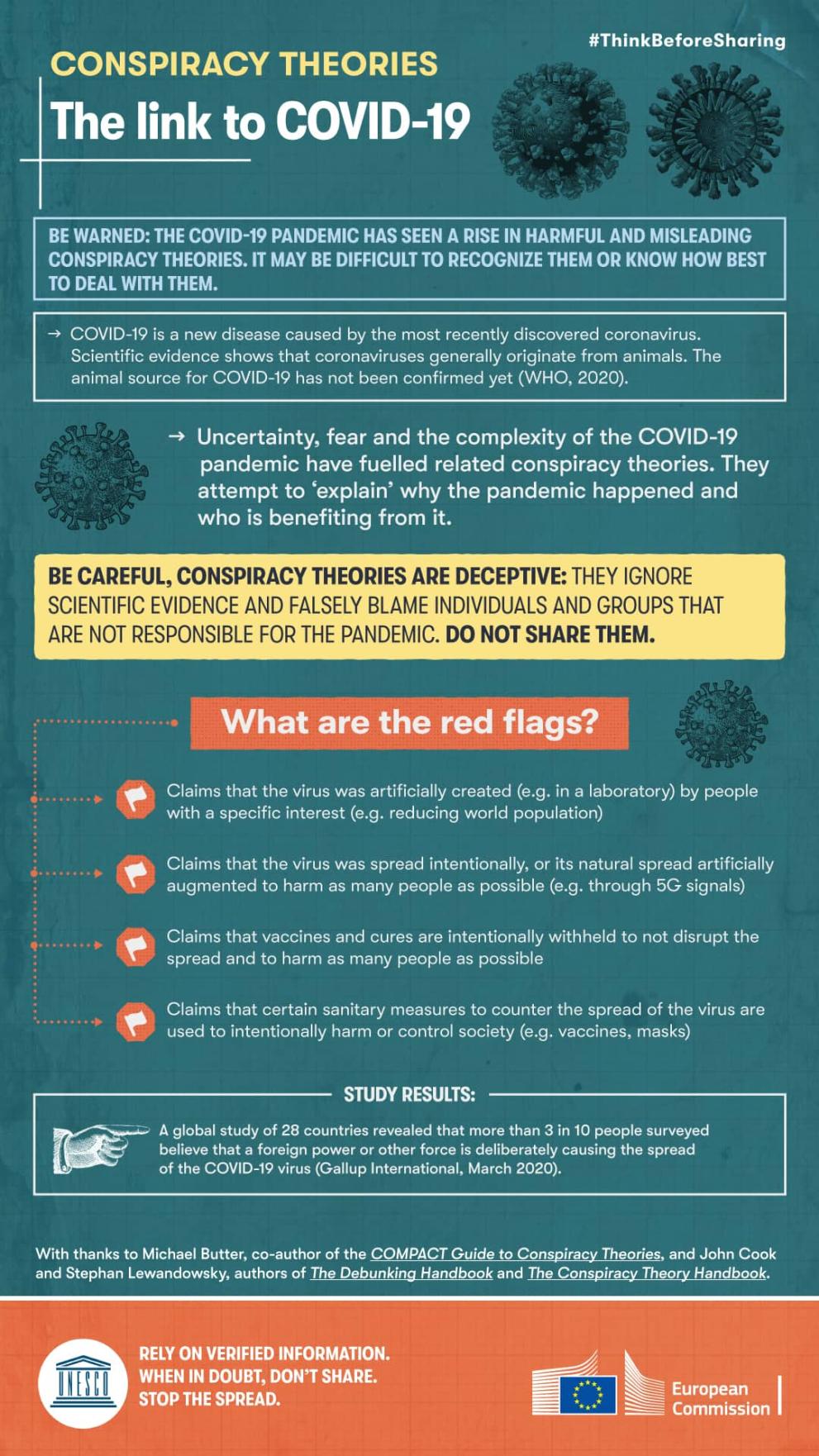

unesco-conspiracy-english-7.jpgunesco-conspiracy-english-7.jpg 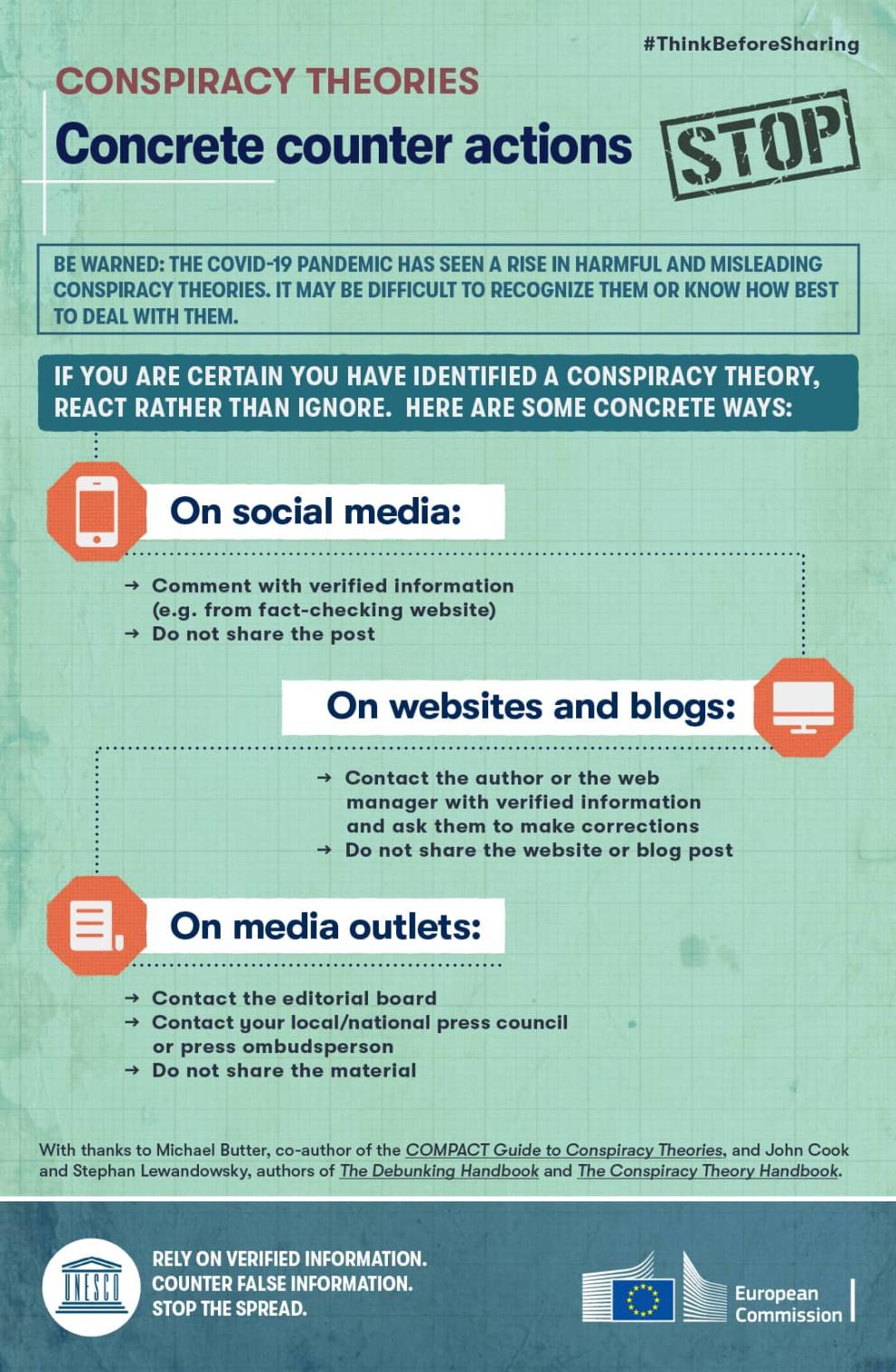
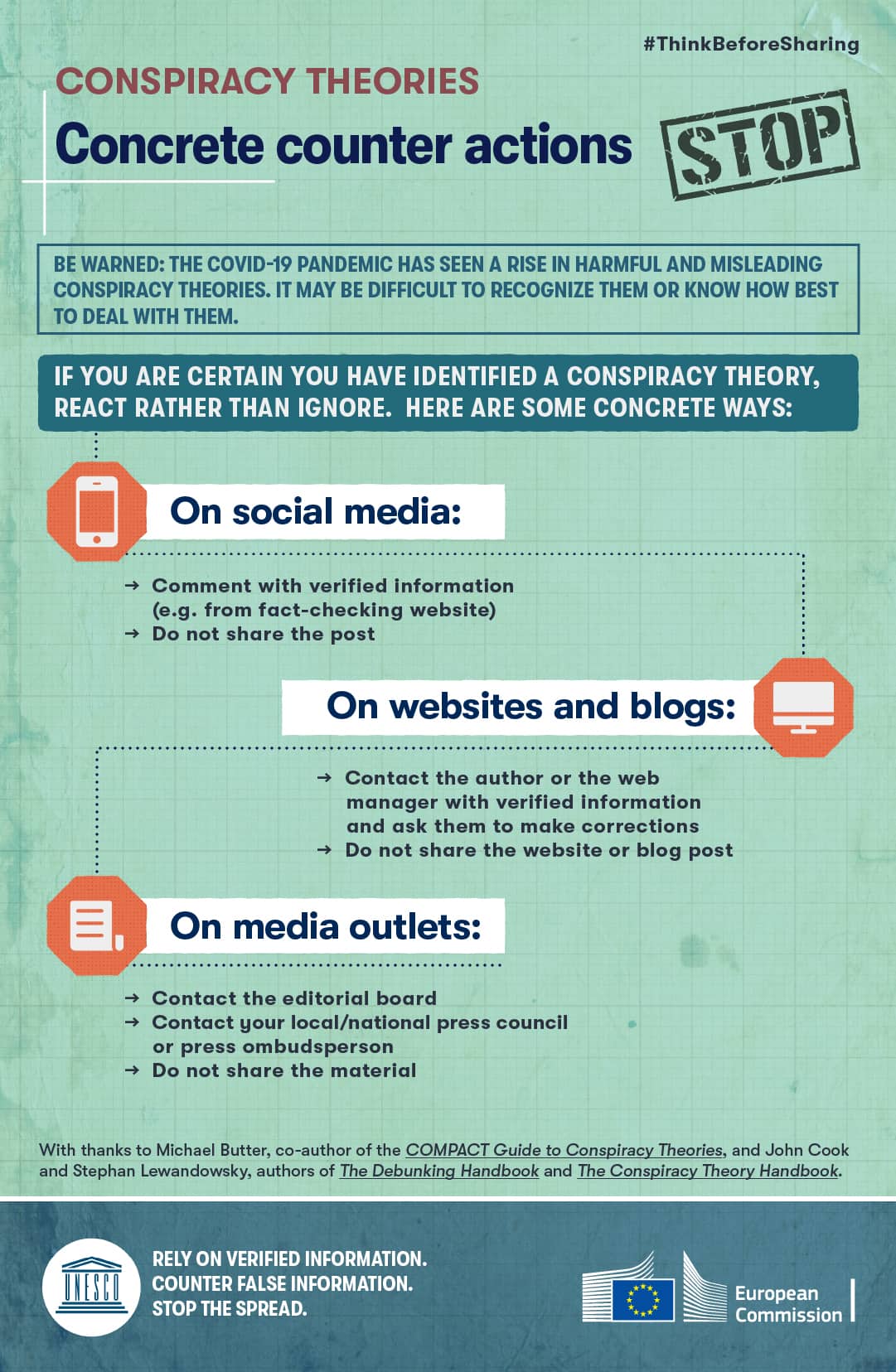
unesco-conspiracy-english-8.jpgunesco-conspiracy-english-8.jpg 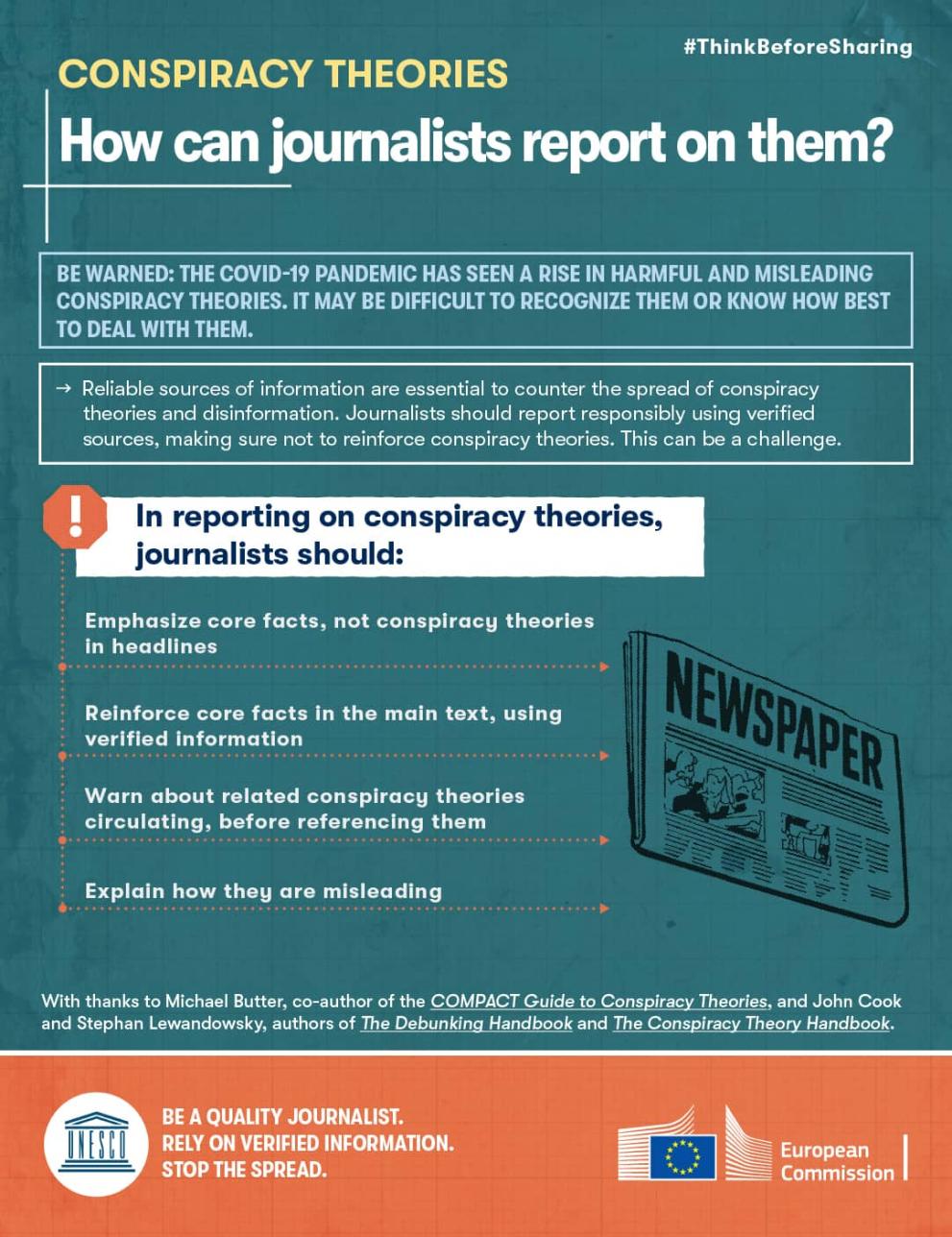

unesco-conspiracy-english-9.jpgunesco-conspiracy-english-9.jpg
Documents
- 12 AUGUST 2020
- 2 OCTOBER 2020
- 5 OCTOBER 2020
- 5 OCTOBER 2020
- 6 NOVEMBER 2020
- 19 FEBRUARY 2021
- 19 FEBRUARY 2021
